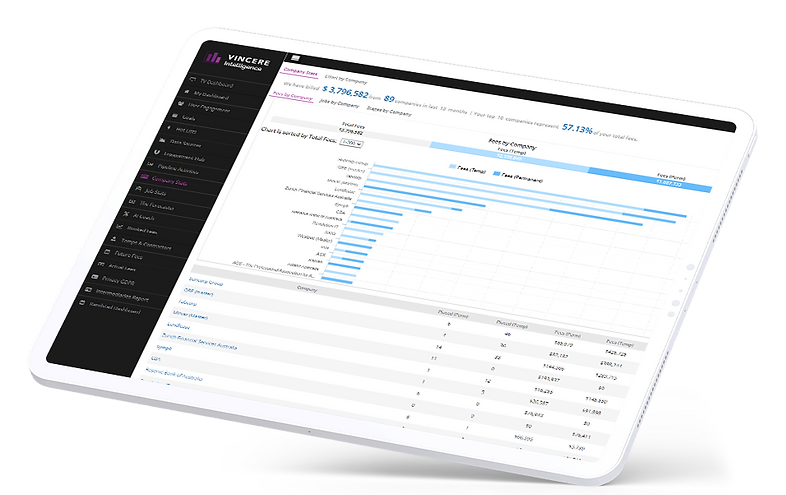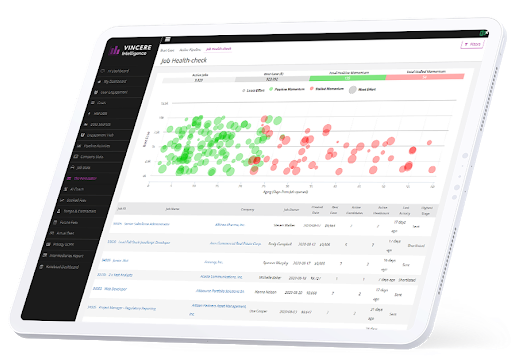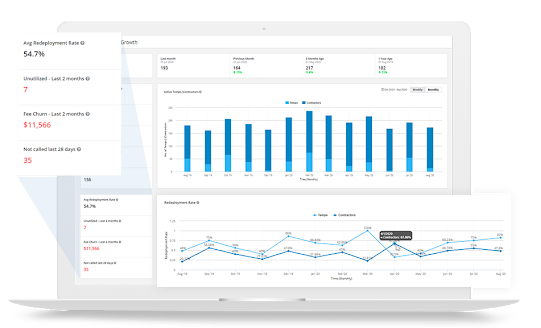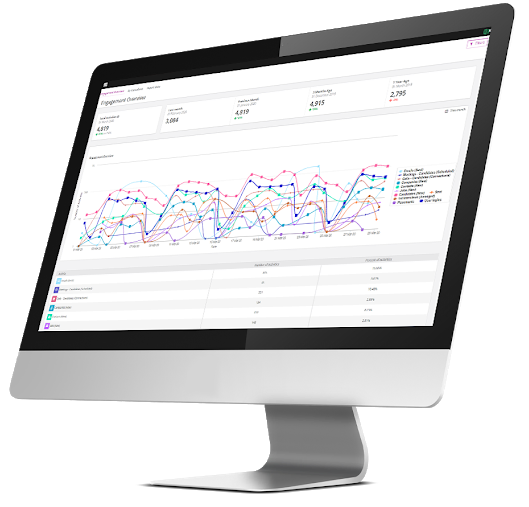
Growing your recruitment agency from the ground up is a mammoth task. Keeping your eye on the business development strategies your recruitment agency is using is essential in building sustainable growth in a competitive market.
Most new staffing agencies make the mistake of focusing only on building their talent pipeline without investing in client relationship management. This relationship management, along with other activities, is what will ensure a stable source of incoming cash flow, and therefore growth.
In this article, we’ll share 7 top tips for business development in recruitment, to help you get more clients. And that's not all – we ’ll also go over 5 key metrics that our top customers use to measure their success.
With these business development tips and strategies, we hope your recruitment agency will walk away with some strong advice on taking your business growth to the next level.
Understanding what makes a good business development strategy
A good business development strategy is a roadmap that guides your organisation to sustainable growth. It's more than just a sales plan; it encompasses a holistic approach to identifying opportunities in the market and maintaining relationships with clients and candidates.
A successful strategy will outline clear objectives, easy- to- follow tactics, and measurable milestones to ensure you're on the right track. The strategy outcomes also need to align with your overall business goals and values, otherwise it won’t support you in your long-term vision.
Finally, an effective business development strategy needs to be adaptable and responsive to change. The market is constantly evolving and your tactics need to be flexible enough to accommodate changes if they shift. Your team will need to continually monitor and refine, to ensure that your strategy remains relevant, and minimise potential risks.
10 recruitment business development strategies for growing agencies
1. Establish and nurture strong client relationships
Having strong relationships with clients is the first step toward your success as a recruitment agency. We recommend that you communicate with customers using a variety of channels: phone calls, emails, instant messages, social media; whatever gets the job done.
Building trust, establishing open communication, and constantly exceeding their expectations makes client retention easier, and helps you to generate repeat business. That’ll also lead to word-of-mouth business, as they become ambassadors for your brand, providing you with valuable referrals that attract new customers.
That said, be mindful that some clients (especially newer ones) may not be interested in what you’re offering. They might not feel it right now, or maybe your message just isn’t convincing. The key is not to overwhelm prospects with messages, but to build a healthy relationship over time. Check in periodically to see how they’re doing, and offer a quick “congratulations” to news of their success.
This is also one of the best sourcing strategies to find top talent as well.
2. Spend time building your reputation
Keeping a consistent brand online is crucial - you don’t want your future prospects to have any doubts when they search for information about your agency. For this reason, make sure that all information on your websites, social media profiles, and other channels is the same. Also, make time to constantly update it.
Keep an eye on things like your brand story, awards, and surveys - which all play a major role in persuading clients to choose you. It also involves consistently delivering high-quality work, demonstrating expertise and professionalism, and actively and positively engaging with your industry and community. The strong reputation you build enhances your credibility, and ultimately contributes to long-term success.
3. Invest in your website
To order to stand out from thousands of competitors, your website should be well-designed, professional-looking, and easy to navigate. Spend time building up content, optimising its UI/UX, and implementing tracking tools for future business development decisions. This overview of website building for recruiters might help.
Your website is a platform for generating leads, nurturing relationships, and driving conversions, so it’s important to prioritise its functionality and design to have a positive impact on drawing in opportunities online.
4. Invest time in SEO
Investing time in Search Engine Optimisation (SEO) is essential for maximising your online visibility and reach. It ensures that your website appears prominently in search for when your potential clients are looking for products, services, or even interesting content that could lead to a future sale.
SEO is a long-term strategy that requires ongoing effort, but the increased visibility and brand awareness it delivers makes it a worthwhile investment for any business development plan.
5. Make "warm-up" connections
No matter how you feel about it, making calls is always an effective strategy when it comes to finding prospects. That said, the traditional way (cold calling) doesn’t always work anymore - you can’t just reach out to potential customers and make empty promises that don’t resonate.
The key to getting clients in recruitment is making sure that they know who you are and what you’ve got to offer before asking for anything. Try some “warm-up” activities first - like connecting with them on Linkedin or other social channels - before picking up the phone. Finding clients through mutual contacts is also an effective “warm-up” plan, as you’ve already got that trust and familiarity with a mutual contact.
6. Have a follow-up plan
Every conversation with clients must end with an action plan for both sides, e.g. scheduling a follow-up call next week. Without a plan, the relationship is unlikely to move forward and end up gaining business. For recruiters looking to secure long-term contracts and develop their staffing business, include action points at the end of every client interaction.
Remember, clients don’t like sellers; they want to be part of an ongoing conversation with a partner that truly cares about their interests. When they’re still considering, take a step back from the pitch and ask yourself what else you can offer, even after reaching an agreement.
7. Market your business
Marketing your business is a fundamental pillar of any successful business development strategy, no matter the industry. This can involve a number of facets, from online advertising to email campaigns, public relations to social media.
By actively promoting your brand and investing into the message you're getting out there, you’re more likely to attract new customers and strengthen relationships with existing ones that see your marketing campaigns.
Read our guide to marketing your recruitment business to get more detail on individual strategies.
8. Engage with social media
Social media has played an indispensable role in business development strategies,y and recruitment agencies are no exception to this rule. By creating genuinely helpful and engaging content, and using a multitude of platforms such as LinkedIn and Instagram, you can engage with an entirely new and modern audience.
Make sure to keep an eye on your comments and direct messages to start building those relationships from the ground up.
9. Digitalise all operations
Finding the right talent to fill up your pipeline may prove to be extremely challenging. There’s a vast talent pool to sort through nowadays, not to mention all the other admin tasks that a recruiter has to deal with. That is where recruitment automation comes in to save the day.
Especially in some specific industries such as medical and mechanical, the effect of digitaliszation is more obvious. Take a look at this example of healthcare staffing software for a better view.
Recruitment agency software makes it easier for staffing agencies to screen and manage candidates. Cloud-based platforms such as Vincere are backed up by powerful AI and machine learning algorithms, paving the way for recruiters to improve productivity and enhance reach to a wider range of clients.
10. Utilise data analytics
Harnessing the power of data is essential for effective business development. Recruitment analytics will help you gain valuable insights into your target audience, their behaviours, and their preference. You can analyse website traffic, social media engagement, and sales data to identify trends and anticipate the needs of your customers.
Recruitment analytics software empowers you to make more informed decisions and switch up your tactics to stay ahead of the curve. Although it’s not a business development strategy per se, this data-driven recruitment will underpin decisions you make for all others and show you opportunities you might not have seen before.
Bonus business development tips: Using 5 metrics to measure success
For many of our customers, agility has been the key to survival. Recruitment business leaders have experienced abrupt shifts in the market, and have been forced to acclimatise to new ways of managing a remote workforce.
Yet one thing we’ve seen in common across our top-performing customers is this: they’ve leaned heavily on insights from Vincere’s recruitment analytics suite to make quick, astute business decisions during the toughest of times.
So if you’re rebuilding your management and business development strategy for the near future, here’s some food for thought. These are 5 key metrics we found our top-performing customers are incorporating into their goals and KPIs.
1. Fees by company and spend by client
However you want to see it, clients need to be the focus of your business development strategy. We’ve seen recruitment agency owners looking for deeper insights into their client data: which of your client accounts offer opportunities for increased revenues, versus those which have the potential to churn? Ultimately, do you know who your biggest clients are...and how much they are spending?
Why it matters
Knowing how much of your total revenue comes from your top ten clients helps you to identify and mitigate risks. If 70% of your business comes from one client...what happens if there is a hiring freeze? If your revenues are spread widely across multiple organisations which of those can you get deeper into?
This goes beyond just looking at those top-line numbers: knowing how much of your consultants' activities are being directed towards each client helps you be aware of the amount of effort versus reward that each of these key accounts represents. This will quickly highlight who your "best" clients are, and which of them are worth prioritising in terms of nurturing the relationship.

Vincere’s pre-built ‘Company Stats’ dashboard shows you metrics like:
- Company Stats
- Fees by Company
- Jobs by Company
- Stages by Company
- Effort by Company
- Activities by Company
- Average Activities per placement
- Avg Activities per 1st interview
2.Open jobs against volume of activity
Do you know which job orders are stalling, and keeping your next clients bottlenecked?
Why it matters
Prioritisation is key to any recruitment agency business development strategy. Your recruiters should not be wasting time focusing on the wrong jobs, chasing hiring managers who lack the urgency to make a decision or candidates who aren’t ready to move.
For you to forecast effectively, you need to manage the health of your pipeline like a hawk- so if jobs have stalled and are "rotting," flush them out of the pipeline and move on. This way, at least your recruiters will have the time to focus on what is real and can result in net fee income (NFI).
Keep a close eye on the velocity of jobs moving through your pipeline and prioritize those with an engaged hiring manager who is moving Candidates forward in the process. If consultants are holding on to jobs in their pipeline which have not progressed in months...get them to take action or close them out from your pipeline. The good news is that the Vincere ‘Job Health Check’ dashboard shows you all of the above in a visual, intuitive manner so you can take action quickly.

Vincere’s out-of-the-box ‘Job Health-check’ dashboard shows you analytics like:
- Best case (forecast of fees in $)
- Least effort versus most effort
- Positive momentum versus stalled momentum
- Ageing (days since the job was created)
3. Redeployment rates
Only 6% of contract recruitment agencies track redeployment rates. This is probably the biggest missed opportunity for contract recruitment businesses. It is also the #1 KPI we see across our top-performing contract businesses, globally.
Redeployment rate is the percentage of workers that you place in a new job/assignment after their current assignment ends.
You need to know:
-
Which of your contractors are finishing? And when?
-
How many of your contractors are unutilised? Which contractors have not been called in the last month?
-
What are your current redeployment and unutilised rates? You can't improve what you don’t measure.
Why it matters
Think about your Contractor Acquisition Cost: that’s all the time and effort you’ve invested into making a successful contract placement, and then getting that contractor compliant and paid. So why not focus on retaining workers and making sure they are all redeployed into new assignments?
If a contractor you’ve previously placed is not working for you, there’s a very high chance they’re working for your competitors.
70% of contractors fail to be redeployed by the agency that placed them. Ouch.
Focus on improving your redeployment rates, that’s easy revenue you shouldn’t be missing out on.

Vincere’s pre-built ‘Temp & Contractor’ dashboard shows you key metrics like:
- Temp/Contractor growth over time
- Active contractors (start of this month)
- Starters & Finishers (this month)
- Net Finishers (this month)
- No. of active Temps / Contractors (weekly, monthly)
- Avg. Redeployment rate
- Redeployment rates over time
- Unutilised contractors (last 2 months)
- Fee churn $ (last 2 months)
- No. of Temp / Contractors not called (last 28 days)
4. Consultant ratios
You’ll certainly want to keep an eye on the level at which your recruitment consultants are performing. This includes looking at CVs Received, CVs Submitted, CVs Sent, 1st Interviews, Placement etc.
Why it matters
Performance management is why it matters.
If you’re already tracking basic metrics like no. of candidate calls, no. of client meetings booked, no. of CVs sent etc, great. But these are simply a measure of activity levels. A high volume of activity does not necessarily make a recruiter a top biller.
Business development in recruitment all comes down to ratios. The smaller the ratio, the more effective and successful a recruiter is.
An understanding of each consultant’s ratios makes a manager's 1-on-1s so much more effective. By deep-diving into the ratios, you can help recruiters work out exactly what needs to be focused on. That’s feedback- and the best part? It’s actionable.

Vincere’s out-of-the-box ‘AI Coach’ dashboard uses machine learning on data collected from your usage of Vincere over the last 12 months to show you:
- Real-time business performance: Target versus Actuals
- Pre-built filers so you can drill down by Brand, Team, Location, Consultant
- Every consultant can view their own personalised dashboard, based on their activity, data and numbers.
5. User engagement: CRM usage & activity levels
To be more specific, this includes recruitment CRM system log-ins, breakdown of system actions, activities and volume.
Why it matters
The benefits are twofold.
Consultants’ engagement with your recruitment CRM system should be constantly monitored and measured on a longer-term basis to track whether your system is being adequately utilized or not. Log-in rates can be high during the initial go-live days, but if they eventually plateau and plummet, that’s an issue.
With working from home being touted as the "new normal," managers can’t see what’s going on unless they have real-time analytics to guide them. How do you know who to support, and when it’s needed the most?
Tell me this: do you know if your consultants are truly busy? Do you know if the business is moving forward as it should be? What did your consultants do today, and what do they need to do tomorrow to move the needle?
Important business and management decisions can be made simply by looking at tech usage and activity levels.
For those interested, check out our list of the top recruitment KPIs necessary for your business's success.

Vincere’s pre-built ‘User Engagement’ dashboards show you:
- Activity overview: total number and type of activity
- Activity by consultant: total number and type that was completed by each consultant
- Report Data - Entity: records that have an activity associated
- Report Data - Drill-Down Log: all activities that were taken inside the platform
Final thoughts
Business development for recruitment agencies can be especially challenging. But with the above strategies and metrics, you should learn how to reach potential clients and scale your staffing business in no time.
Ready to take your recruitment agency to the next level? Learn more about our all-in-one recruitment agency software - designed to address the pain points of any recruitment agency in a single end-to-end platform and unlock agency growth.
You may also be interested in:
